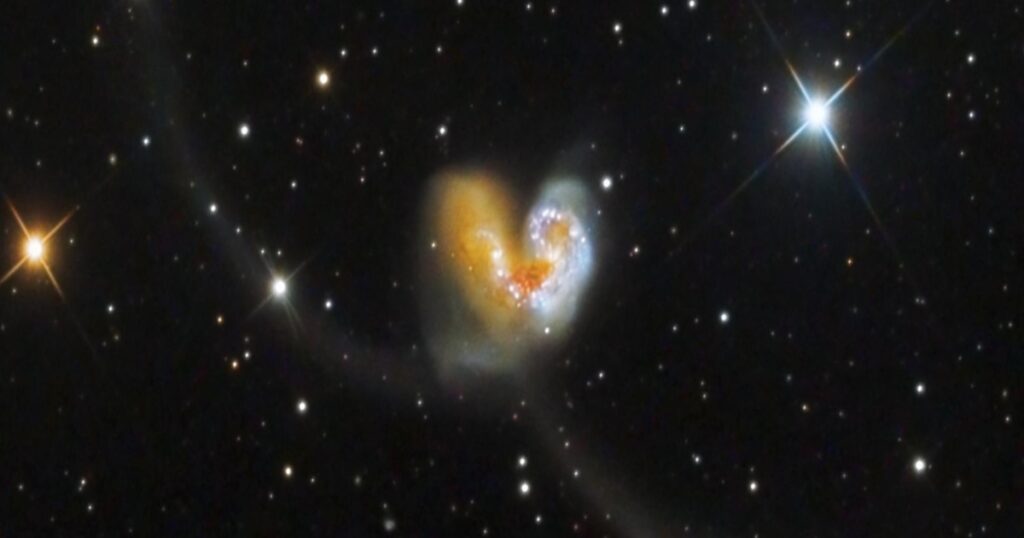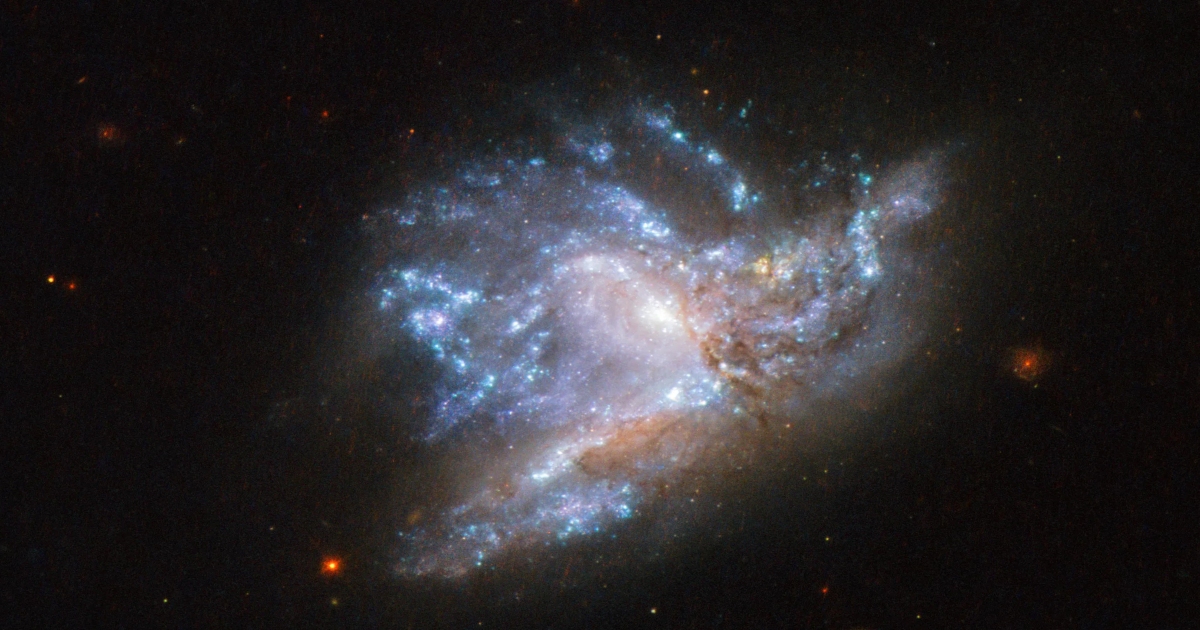When galaxies collide, it’s a slow-motion smashup, lasting billions of years. Their gravity pulls and twists them, igniting a burst of star formation. Gas clouds slam together, birthing new stars. Over time, they’ll merge into a single, often elliptical galaxy.

What happens When Galaxies Collide?
When two or more galaxies collide, it’s a slow-motion ballet, stretching over millions or even billions of years. As the galaxies inch closer, their immense gravity begins to exert its influence. Their once-graceful spiral arms, adorned with vibrant star clusters and nebulae, become distorted, warping, and twisting under the gravitational pull.
This initial encounter triggers a chain reaction within the galaxies. Gas clouds, the fuel for star formation, slam into each other with tremendous force. This compression acts like a cosmic lighter, igniting a frenzy of star birth.
The once-quiet corners of the galaxies erupt in a dazzling display of young, hot stars, their brilliance painting the celestial canvas with vibrant hues of blue and white.
The Chaotic Aftermath:
The collision doesn’t just trigger star formation; it throws the galaxies into a state of upheaval. The immense gravitational forces can fling vast amounts of gas and dust outwards, forming long, wispy tails that stretch for millions of light-years across the cosmos.
These tails, a testament to the violence of the encounter, are a beautiful yet chaotic reminder of the ongoing galactic dance.
The collision can also have a significant impact on the individual stars within the galaxies. Some stars may be flung out entirely, becoming unbound wanderers in the vast interstellar space. Others may find themselves hurtling toward the center of the merged galaxy, potentially getting consumed by a supermassive black hole residing there.
A Merged Future:
After countless orbits and interactions, the two galaxies will eventually succumb to the relentless pull of gravity and merge entirely. This doesn’t happen overnight; it’s a gradual process that can take hundreds of millions of years.
The resulting entity is often an elliptical galaxy, a vast, oval-shaped structure devoid of the graceful arms that once characterized its parents.
Elliptical galaxies are typically devoid of the active star formation seen in spiral galaxies like our Milky Way. This is because the collision has used up much of the readily available gas and dust needed to form new stars.
However, the merger can also trigger the growth of supermassive black holes at the galaxies’ centers, potentially leading to a surge in activity as the black holes devour the infalling material.
What did we learn from Antennae Galaxies Collision?

The most striking consequence of the collision is the intense star formation happening within the Antennae Galaxies. The gravitational pull between the galaxies compresses vast clouds of gas and dust, acting like a giant cosmic fuel injector.
This compressed gas becomes denser and hotter, triggering the birth of a phenomenal number of new stars. Observations of the Antennae Galaxies reveal vibrant regions bursting with young, hot stars, a testament to the ongoing starburst.
The extreme environment within the colliding galaxies allows scientists to study stellar evolution under unique conditions. The compressed gas clouds and shockwaves can trigger the formation of massive stars, many times heavier than our Sun.
Studying these behemoths helps us understand their role in shaping galaxies, enriching the interstellar medium with heavy elements through stellar explosions, and potentially influencing the formation of planetary systems.
Galaxy collisions aren’t just about creating new stars, they can also disrupt the lives of existing ones. Some stars get flung outwards by the gravitational chaos, becoming unbound wanderers in the vast expanse of space.
Others may find themselves hurtling toward the center of the merged galaxy, potentially getting devoured by a supermassive black hole residing there. Studying the Antennae Galaxies helps us understand the dramatic impact of galactic encounters on stellar populations.
Galaxy collisions can also influence the behavior of supermassive black holes lurking at the hearts of these giants. As the galaxies merge, the black holes may interact with each other, potentially unleashing tremendous energy and providing clues about their growth and influence on galactic environments.
Studying the Antennae Galaxies helps us refine models of black hole behavior and their role in galactic dynamics.
Conclusion:
Galaxy collisions are a stark reminder that the universe is not a static place. Galaxies are constantly evolving, interacting with each other, and reshaping themselves through celestial encounters.
These collisions are not just destructive; they are also creative forces, leading to the birth of new stars, the growth of supermassive black holes, and the formation of entirely new galactic structures.
As we continue to peer into the depths of space with ever-more powerful telescopes, the story of galaxy collisions will undoubtedly continue to unfold. These cosmic ballets of destruction and creation offer a glimpse into the grand narrative of the universe, a story of constant change and evolution that has been playing out for billions of years.
